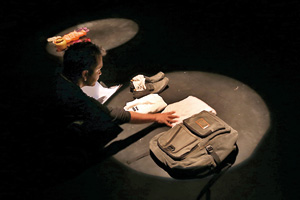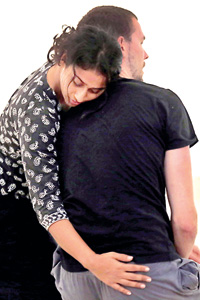Traffic-stopping art and more!
The inaugural Live Art programme at this year’s Colombo Art Biennale (CAB) was equal parts entertaining, thought provoking and slightly, just slightly-baffling. The live artists each brought to the table a great understanding of their performance, yet occasionally that understanding may not have been communicated as well as it should have been to the audience. Overall though, CAB has provoked us to think once more- just like it did last week.

The other side of war: Jake Oorloff in the spotlight
The programme kicked off with a touch of the risqué, as the enigmatic Bandu Manamperi returned to the streets of Colombo with his ironing act, complete with red boxers and a growing audience of curious bystanders. Manamperi’s act was immediately followed by the official opening of the Biennale’s Live Art segment by Jake Oorloff, who responded to T. V. Santosh’s Effigies of Turbulent Yesterdays with ‘Othered Histories’. Oorloff (a theatre practitioner based in Colombo) had chosen well as the artwork he was responding to was one of the exhibition’s most striking; a black beast of a horse mounted by a headless man with glowing red stopwatches embedded into it, Santosh captures a rather graphic side of art in glorifying violent history with his work.
Oorloff responded with a reading made up of three parts; the stories of a sibling and parents who had lost their loved ones to conflict. The intensity of the performance was amplified by the intimate audience and dim lighting, with a spotlight on Oorloff alone and the rest in darkness. While the performer was very occasionally inaudible, it was a thought provoking insight into the other side of war, the unheard stories of the families who lose a loved one but not their memories.

Interlinked: Venuri Perera and Thomas Pritchard. Pix by M.A. Pushpa Kumara
The next moment of live art we were privy to was markedly different in that it took place in a brightly lit gallery, amongst a fairly large crowd of people. ance/theatre performers Thomas Pritchard and Venuri Perera took on the theme of ‘Unmaking’. Pritchard began the session by walking, shuffling and crawling his way through the many artworks of the JDA Gallery’s 3rd floor, finding inspiration in exhibits like the Fireflies’ patch worked collection of sarees and Nina Mangalanayagam’s montage of photographs. Pritchard was soon joined by Perera; as skilled and graceful in her movement as she is with her facial expression, Perera interlinked her performance with Pritchard’s; the two finding symmetry in their actions.
Perera made another appearance on Friday the 7th at Goethe Institut together with Priyanthi Anusha. The duo examined identity politics with their piece which explored each performer’s defining ‘traits’, or those that society chose to perceive them with based on gender. The almost clinical reading was juxtaposed by a figure engaging in a daily ritual behind a translucent screen, made all the more revealing for the privacy of the act.
On Tuesday the 4th Adrian Schvarzstien’s young students sang ‘happy birthday to Sri Lanka’ all over Colombo 07. Starting with a small gathering at the Park Street Mews, they encouraged the audience to overcome inhibitions and follow them out into the glaring heat of a midday sun; up Park Street, across the crossing lines and into the Viharamahadevi Park we went. In the interim, they had stopped traffic, pretending to ride brooms and galloping away into the distance. “How’s that,” we hear someone laugh. “Traffic in Sri Lanka actually stops for some things.”
At Viharamahadevi Park the entertainers delighted; children pointed and giggled, screaming in delight as the group took on a mock attack formation and sang for them. Adults stopped, ice creams forgotten and melting in their hands as this bizarre group of young things happily stomped their way through the park, spilling into the streets and drawing laughs from a usually reserved Sri Lankan public.
 So did Olivier Grossetete, who spent the biennale’s duration at Independence Square building his ‘People’s Tower’. The French artist travels the world armed with cardboard, scotch tape and a pair of scissors and says it’s the chaotic beauty of “making architecture with cardboard’ that inspires him to engage with the day to day lives of other people, convincing them to take a break and add to the towering installation. Grossetete had picked up a thing or two during his stay-his confident ‘ekaai, dekaai, thunaaai, ussanaa!’ (one, two, three, lift) drew its fair share of giggles from the participants. On Saturday a week’s worth of building came to a culmination with a large gathering at Independence, and at 6 p.m. the towering masterpiece came crumbling down as the artist’s licence to occupy the space came to an end.
So did Olivier Grossetete, who spent the biennale’s duration at Independence Square building his ‘People’s Tower’. The French artist travels the world armed with cardboard, scotch tape and a pair of scissors and says it’s the chaotic beauty of “making architecture with cardboard’ that inspires him to engage with the day to day lives of other people, convincing them to take a break and add to the towering installation. Grossetete had picked up a thing or two during his stay-his confident ‘ekaai, dekaai, thunaaai, ussanaa!’ (one, two, three, lift) drew its fair share of giggles from the participants. On Saturday a week’s worth of building came to a culmination with a large gathering at Independence, and at 6 p.m. the towering masterpiece came crumbling down as the artist’s licence to occupy the space came to an end.
Back at the JDA Gallery Thomas Pritchard has sidled up to us and whispered, ‘we are free, but are we free really?’ Thrown off kilter by the suddenness of it all, he only receives a mute shrug from us. But later that night, back in the safe, non-provocative confines of our own homes we think over it. We think, and still have no answer. Pritchard, together with his fellow live art performers, had opened our eyes to a new possibility. They’ve made us question how we respond to things, to life itself. There’s an alternative you know, they’ve told us. You can be different. You can make history what you want it to be.



